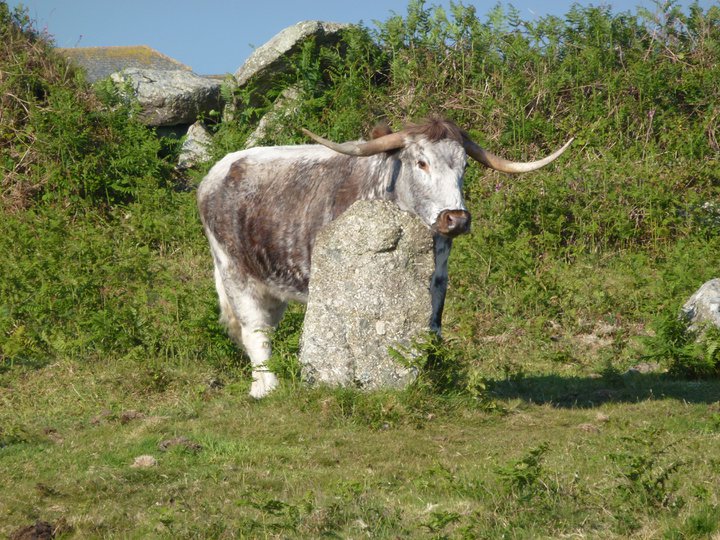A member of the Cornish Branch of the Celtic League has written to English Heritage in response to the publication of their report and recommendations for the future management of Tregeseal stone circle.  Source - Save Penwith
Source - Save Penwith
A member of the Cornish Branch of the Celtic League has written to English Heritage in response to the publication of their report and recommendations for the future management of Tregeseal stone circle. (voir le site) [1].jpg" width="200" height="200" alt="cattle rubbing against the standing stones" /> Source - Save Penwith Moors In his enquiry, Matt Blewett questions the statement made in the report by author and Assistant Inspector of Ancient Monuments for English Heritage, Nick Russell that damage to the stone circle could have been caused by visitors to the site. Mr Blewett argues that he is in possession of an email from Ann Preston-Jones from English Heritage that says that claims that damage caused to the stones by people is speculative opinion only, because there is no evidence that this is the case. In his correspondence Mr Blewett therefore questions Mr Russell's suggestion that visitors to the site are causing an equal amount of damage to the stones as the cattle. In conclusion, Mr Blewett writes: The communications I have from English Heritage contradict the substance of this report, and calls into question the legitimacy of your conclusions. To include this entirely speculative opinion in a formal report as an established fact, without any evidence, degrades the whole report and demonstrates an anti-visitor bias on the part of English Heritage, raising the likelihood of future exclusion of people while the real damage continues to the destruction of our heritage. The full text of Mr Blewett's letter can be found below. Dear Nick Russell, Thank you for your report on the damage to Tregeseal stone circle, attached. I have one main query about it. I have in my possession an email from Ann Preston-Jones (of English Heritage) that explicitly admitted that claims of damage by people (that remain an equal concern to damage by cattle in this report) are based entirely on speculative opinion on the basis of no evidence whatsoever. Conversely there are recorded images of cattle rubbing against the stones. Historically in Cornwall, and as recorded by Meyn Mamvro, damage to historic remains is usually perpetrated by those with the duty to look after them, and also that damage is often inflicted specifically to prevent visitors access to our past (Meyn Mamvro, from issue 1). While I doubt that English Heritage is anti-Cornish to the extent of deliberately damaging ancient monuments, this report does appear to be another instance of the perpetrator blaming the victim. The report you sent presents no evidence for damage by visitors, yet visitors are still cited on an equal level with proven cattle damage. All the while the grazing regime continues. Page 4 claims that visitors lean on stones nearest the path. However Ann Preston-Jones provided no evidence of this when I asked, but instead presented visitor damage as being her personal opinion and not based on evidence. Can you now provide evidence for any visitors that you have observed lean on the stones, and by that I mean not at your instigation or remuneration? The communications I have from English Heritage contradict the substance of this report, and calls into question the legitimacy of your conclusions. To include this entirely speculative opinion in a formal report as an established fact, without any evidence, degrades the whole report and demonstrates an anti-visitor bias on the part of English Heritage, raising the likelihood of future exclusion of people while the real damage continues to the destruction of our heritage. I will share your report with archaeological colleagues, along with my concerns about it. Yours, Matt Blewett, BA (Hons), MA For comment or clarification on this news item in the first instance contact: Rhisiart Tal-e-bot, General Secretary, Celtic League: Tel: 0044 (0)1209 319912
M: 0044 (0)7787318666 gensec [at] celticleague.net The General Secretary will determine the appropriate branch or General Council Officer to respond to your query. ISSUED BY THE CELTIC LEAGUE INFORMATION SERVICE. 02/01/12
 The Celtic League has branches in the six Celtic Countries. It works to promote cooperation between these countries and campaigns on a broad range of political, cultural and environmental matters. It highlights human rights abuse, monitors all military activity and focuses on socio-economic issues.
TEL (UK) 01624 877918
MOBILE (UK)07624 491609
(voir le site)
The Celtic League has branches in the six Celtic Countries. It works to promote cooperation between these countries and campaigns on a broad range of political, cultural and environmental matters. It highlights human rights abuse, monitors all military activity and focuses on socio-economic issues.
TEL (UK) 01624 877918
MOBILE (UK)07624 491609
(voir le site)
